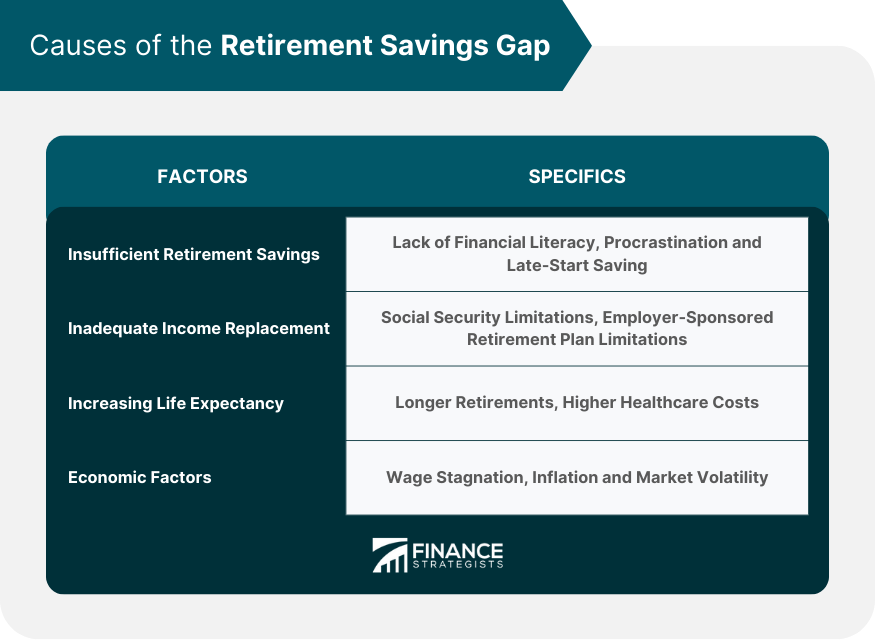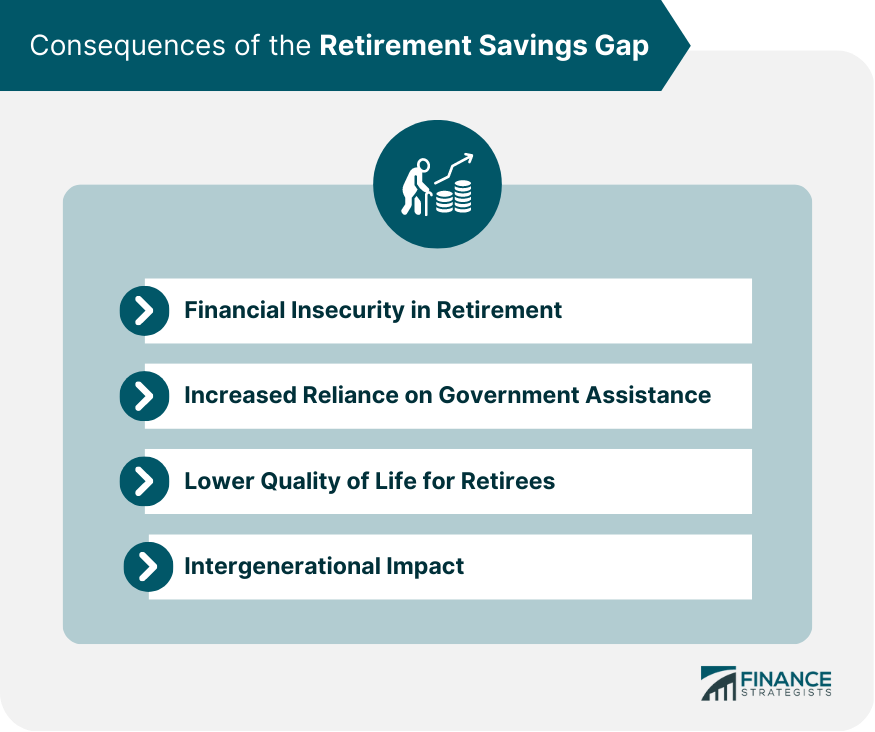The retirement savings gap is a critical financial issue that refers to the difference between the amount of money needed for a comfortable retirement and the actual savings accumulated by individuals. This gap highlights the potential financial shortfall faced by retirees, which can lead to financial insecurity and a decreased quality of life. Addressing the retirement savings gap is essential for ensuring financial stability and independence in retirement, reducing the burden on government assistance programs, and promoting overall economic well-being. Financial illiteracy can lead to poor financial decisions and a lack of understanding of the importance of saving for retirement. Individuals who lack financial knowledge may not start saving early enough, invest too conservatively, or fail to diversify their investments, leading to insufficient retirement savings. Many individuals procrastinate saving for retirement, believing they have plenty of time to catch up later. However, this often leads to a significant savings shortfall, as the benefits of compound interest are reduced when individuals start saving later in life. Social security benefits are not designed to fully replace pre-retirement income, typically replacing only about 40% of an individual's average earnings. As a result, relying solely on social security benefits can lead to a retirement savings gap. Not all employers offer retirement plans, and those who do may have limited employer contributions or low participation rates among employees. Additionally, employees may not contribute enough to their plans, leading to inadequate income replacement in retirement. As life expectancy increases, retirees face longer periods of retirement, which requires a larger nest egg to maintain their desired standard of living. Longer life spans also correlate with higher healthcare costs in retirement, further exacerbating the retirement savings gap for many individuals. Wage stagnation can make it difficult for individuals to save for retirement, as they struggle to keep up with the rising cost of living. Inflation and market volatility can erode the purchasing power of retirement savings, making it challenging for individuals to maintain their desired standard of living in retirement. A significant retirement savings gap can lead to financial insecurity, forcing retirees to downsize their lifestyles, rely on family members, or return to work to supplement their income. As more individuals face a retirement savings gap, there is increased pressure on government assistance programs, such as Social Security and Medicare, which may become unsustainable in the long term. A lack of sufficient retirement savings can lead to a lower quality of life for retirees, as they may struggle to afford basic necessities, healthcare, and leisure activities. The retirement savings gap can also create an intergenerational burden, as financially insecure retirees may require support from their adult children, limiting the younger generation's ability to save for their own retirement. Starting to save early and consistently is crucial for accumulating a sufficient retirement nest egg. By taking advantage of compound interest, individuals can grow their savings over time and reduce the likelihood of facing a retirement savings gap. A diversified investment portfolio can help individuals protect their retirement savings from market volatility and inflation. By investing in a mix of assets, such as stocks, bonds, and real estate, individuals can mitigate risk and increase their potential for growth. Working longer can help individuals increase their retirement savings and reduce the number of years they need to rely on their savings, thus narrowing the retirement savings gap. Improving financial literacy through education can help individuals make informed decisions about their retirement savings, increasing the likelihood of achieving their retirement goals. Employers can play a critical role in bridging the retirement savings gap by offering retirement plans to their employees, making it easier for individuals to save for their future. Employers can help increase retirement plan participation rates by automatically enrolling employees and implementing automatic contribution escalation, which gradually increases employees' contribution rates over time. Employers can offer financial wellness programs, including retirement planning seminars, financial counseling, and access to financial planning tools, to help employees better understand and manage their retirement savings. Policymakers can help address the retirement savings gap by implementing reforms to strengthen Social Security, ensuring the program remains solvent and can continue to provide a safety net for retirees. Governments can encourage individuals to save for retirement by offering tax incentives, such as tax deductions or tax credits for retirement plan contributions. Policies aimed at increasing wages, such as minimum wage increases and efforts to promote pay equity, can help individuals save more for retirement, ultimately reducing the retirement savings gap. Addressing the retirement savings gap is crucial for ensuring a secure and comfortable retirement for all individuals, reducing the burden on government assistance programs, and promoting overall economic well-being. Closing the retirement savings gap requires the combined efforts of individuals, employers, and the government. By implementing targeted strategies and working together, these stakeholders can help ensure that everyone has the opportunity to achieve financial security in retirement. As the retirement savings gap continues to be a pressing issue, it is essential to maintain focus on developing and implementing innovative solutions. By learning from successful examples and adapting them to local contexts, stakeholders can work together to ensure a secure retirement for current and future generations.What Is the Retirement Savings Gap?
Causes of the Retirement Savings Gap
Insufficient Retirement Savings
Lack of Financial Literacy
Procrastination and Late-Start Saving
Inadequate Income Replacement
Social Security Limitations
Employer-Sponsored Retirement Plan Limitations
Increasing Life Expectancy
Longer Retirements
Higher Healthcare Costs
Economic Factors
Wage Stagnation
Inflation and Market Volatility

Consequences of the Retirement Savings Gap
Financial Insecurity in Retirement
Increased Reliance on Government Assistance
Lower Quality of Life for Retirees
Intergenerational Impact

Strategies for Bridging the Retirement Savings Gap
Individual Level
Early and Consistent Saving
Diversifying Investments
Delaying Retirement
Financial Education
Employer Level
Expanding Access to Retirement Plans
Automatic Enrollment and Escalation
Providing Financial Wellness Programs
Government Level
Strengthening Social Security
Encouraging Retirement Savings Through Tax Incentives
Implementing Policies to Address Wage Stagnation and Income Inequality
Conclusion
The Significance of Addressing the Retirement Savings Gap
The Role of Individuals, Employers, and the Government in Bridging the Gap
A Call for Continued Efforts and Innovative Solutions to Ensure a Secure Retirement for All
Retirement Savings Gap FAQs
The retirement savings gap refers to the difference between the amount of money individuals will need to support their desired lifestyle in retirement and the amount of retirement savings they have accumulated to date.
The retirement savings gap is a concern because it can leave individuals with insufficient funds to support their retirement lifestyle. This can result in individuals having to make difficult financial decisions or adjust their retirement plans.
Individuals can determine if they have a retirement savings gap by evaluating their retirement income needs, estimating their retirement savings, and comparing the two. A retirement planner or financial advisor can also help individuals assess their retirement savings gap and develop strategies to address it.
Strategies for addressing the retirement savings gap can include increasing retirement savings contributions, delaying retirement, working part-time in retirement, downsizing living expenses, and exploring alternative retirement income sources such as rental income or a reverse mortgage.
Employers can help address the retirement savings gap by offering retirement savings plans such as 401(k)s, providing matching contributions or other incentives for retirement savings, and offering financial education and resources to employees. Employers can also consider offering phased retirement options or flexible work arrangements to help employees transition into retirement.
True Tamplin is a published author, public speaker, CEO of UpDigital, and founder of Finance Strategists.
True is a Certified Educator in Personal Finance (CEPF®), author of The Handy Financial Ratios Guide, a member of the Society for Advancing Business Editing and Writing, contributes to his financial education site, Finance Strategists, and has spoken to various financial communities such as the CFA Institute, as well as university students like his Alma mater, Biola University, where he received a bachelor of science in business and data analytics.
To learn more about True, visit his personal website or view his author profiles on Amazon, Nasdaq and Forbes.











